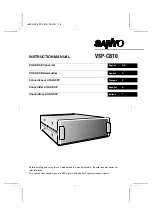
8052 Instruction Set
E-5
8052 Instruction Set
The auxillary carry (AC) bit is set if there is a carry-out of bit 3. In other words,
if the unsigned summed value of the low nibble of the accumulator, operand,
and (in the case of ADDC) the carry flag exceeds 15, the auxillary carry flag
is set. Otherwise, the auxillary carry flag is cleared.
The overflow (OV) bit is set if there is a carry-out of bit 6 or out of bit 7, but not
both. In other words, if the addition of the accumulator, operand, and (in the
case of ADDC) the carry flag treated as signed values results in a value that
is out of the range of a signed byte (−128 t127), the Overflow flag is
set. Otherwise, the Overflow flag is cleared.
See also: SUBB, DA, INC, DEC
AJMP
Absolute Jump within 2k Block
Syntax
AJMP codeAddress
Instructions
OpCode
Bytes
Cycles
Flags
AJMP pg0Addr
0x01
2
2
None
AJMP pg1Addr
0x21
2
2
None
AJMP pg2Addr
0x41
2
2
None
AJMP pg3Addr
0x61
2
2
None
AJMP pg4Addr
0x81
2
2
None
AJMP pg5Addr
0xA1
2
2
None
AJMP pg6Addr
0xC1
2
2
None
AJMP pg7Addr
0xE1
2
2
None
AJMP unconditionally jumps to the indicated codeAddress. The new value for
the program counter is calculated by replacing the least-significant-byte of the
program counter with the second byte of the AJMP instruction, and replacing
bits 0−2 of the most-significant-byte of the program counter with bits 5−7 of the
opcode value. Bits 3−7 of the most-significant-byte of the program counter re-
main unchanged.
Jumps must only be made to code located within the same 2k block as the first
byte that follows AJMP because only 11 bits of the program counter are af-
fected by AJMP.
See also: LJMP, SJMP
















































